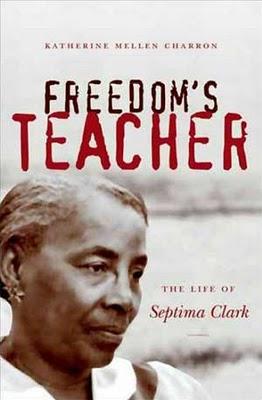Freedom’s Teacher: The Life of Septima Clark

When Septima Clark began teaching in 1919, she quickly learned that good education is very much like community organizing. Both start by identifying pressing needs, involve the affected in formulating solutions, and give them a stake in the final outcome. Freedom's Teacher tells Clark’s story, and while the writing is drily academic, the book is an important reminder that each of us can make a dent in the status quo.
Clark was a teacher’s teacher, a skilled motivator and a driven, hard-working, proponent of human equality and the power of the classroom to encourage and provoke social change. Her personal life was not easy—her husband died young and she was forced to send her son to live with his paternal grandparents—but her ability to shift gears and accept new opportunities, even in late middle age, is inspiring.
Born to working class parents, her first job was on Johns Island, a tiny underdeveloped farm community off the coast of South Carolina. Clark did not go to the island by choice. In fact, the position was the only placement she could find since her native city, Charleston, refused to hire African Americans to teach in the city’s segregated schools. Johns Island, populated by largely illiterate Black farmers, challenged the fledgling educator whose would-be students lived in such intense poverty that they had to work in the fields instead of attending classes.
But what to do? Clark understood that getting islanders to allow their children to study would be difficult so she began going door to door, speaking about the benefits of formal coursework. “At every turn, Charron writes, “success mandated creativity.” It also mandated that Clark get involved in people’s everyday lives, not only learning Gullah, but also helping them write letters, fill out forms, and determine crop prices and proper wages. What’s more, free evening literacy classes for adults—taught by Clark—gave residents the tools to expand their options. Decades later, Clark brought this experience to the civil rights movement, crafting adult literacy classes to activate and empower those who attended.
The few years Clark spent on Johns Island radicalized her, and Charron describes Clark’s increased agitation over the miserable conditions her students had to contend with, including a decrepit, unheated school building, inadequate supplies, and non-existent text books. Protests against racial disparities set her on a course that would last six-plus decades. Furthermore, her quest for justice prompted her to get involved in numerous civic and civil rights groups including the Highlander Folk School, the YWCA, and the Southern Christian Leadership Conference’s Citizenship Education Program [CEP].
Women formed the crux of the CEP, teaching unschooled southerners how to pass literacy tests so that they could vote and then discussing everything from racist laws to activist strategies for changing them. Clark was the force behind much of the CEP’s work, toiling behind the scenes but receiving few accolades for her intrepid work.
Unfazed, Clark never lost sight of the big picture, continually condemning government spending on war and the concomitant failure to provide adequate funds “to end joblessness, slum conditions, and to correct educational deprivation in the ghettos.” Similarly, she never lost her faith in movements for world betterment and her cautious optimism—which lasted until her death in 1987—was infectious.
Clark’s example reminds us that change is never linear or free of backlash. While she picked her battles, Clark knew the importance of nonviolent resistance. As she saw it, watching from the sidelines was never an option.